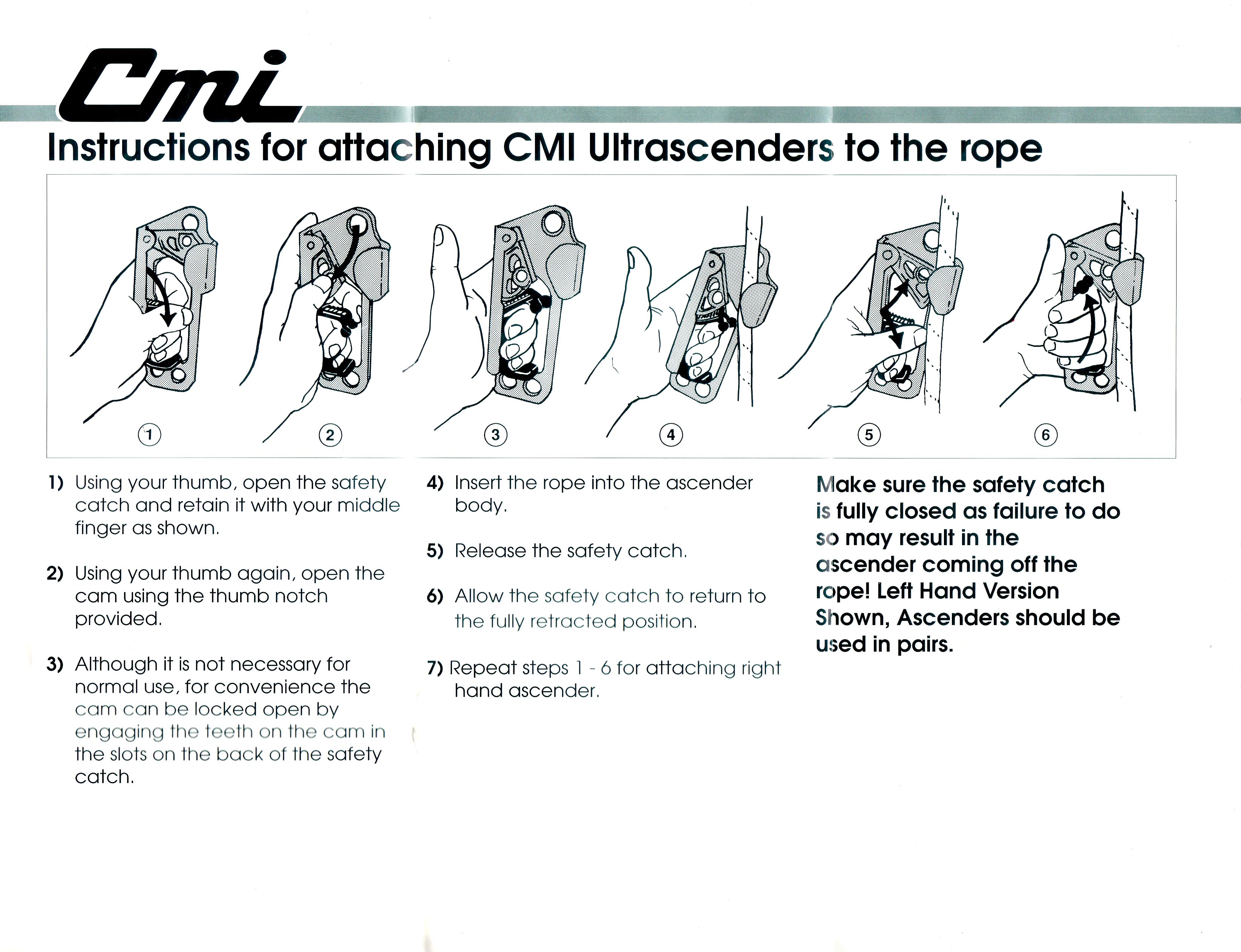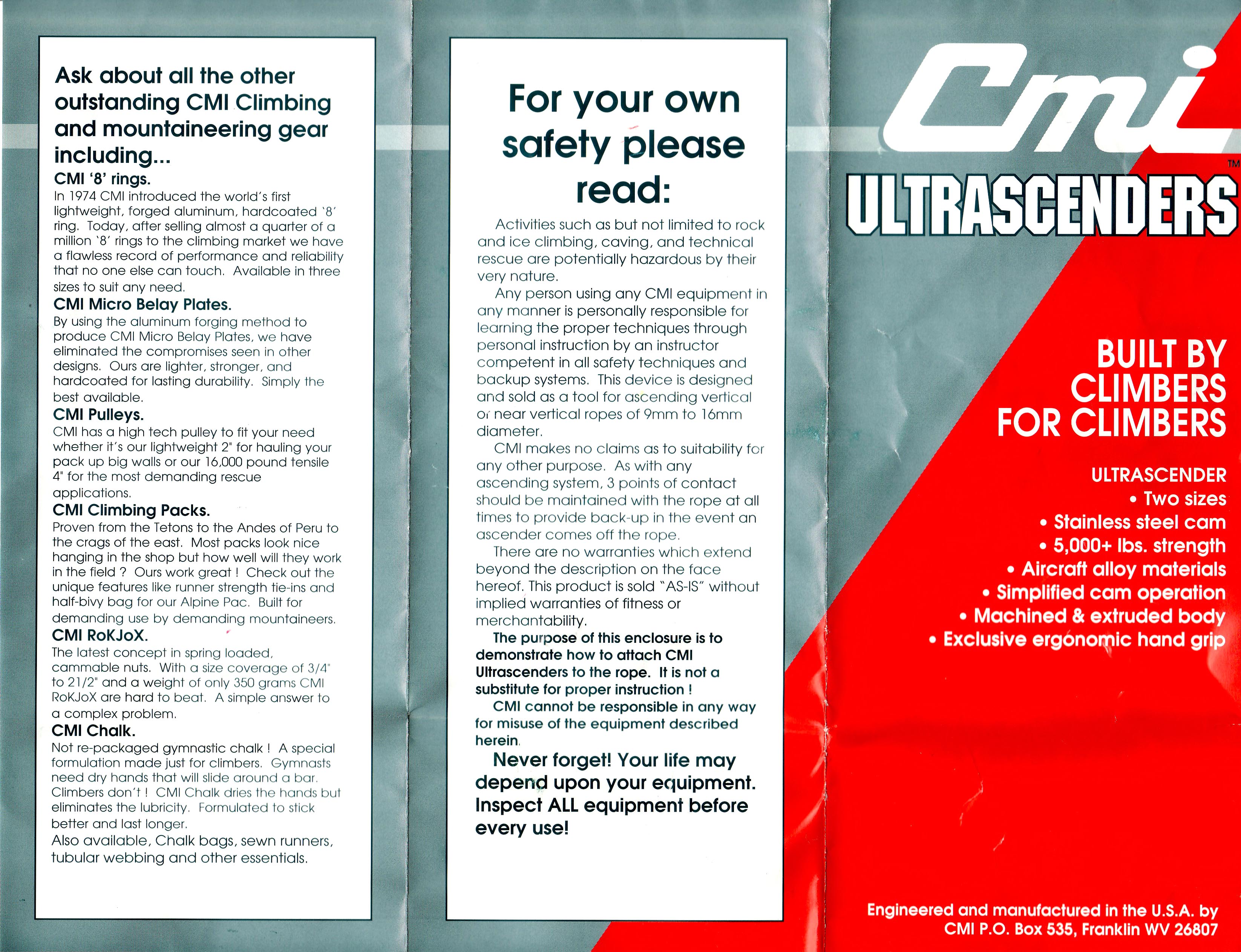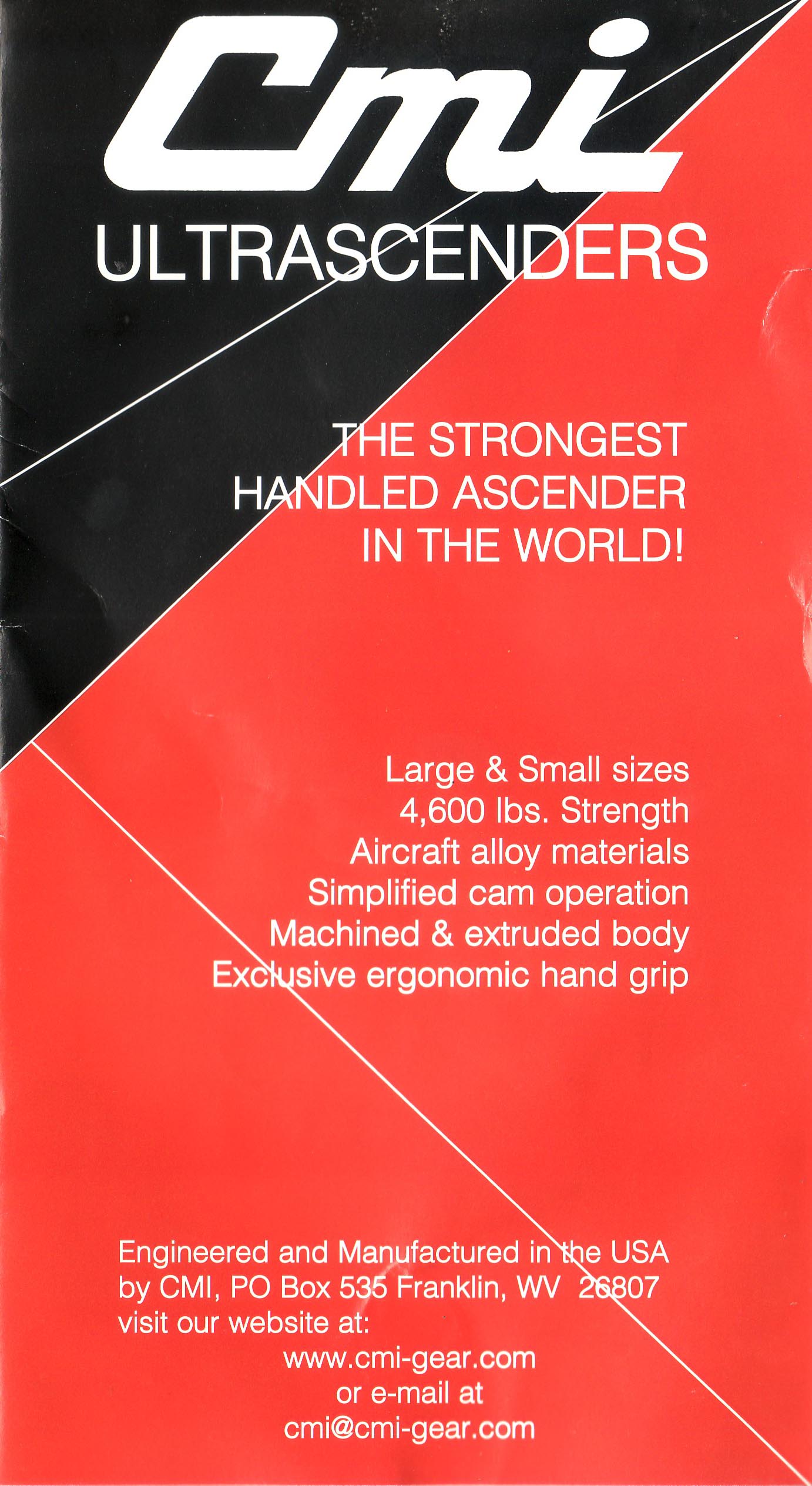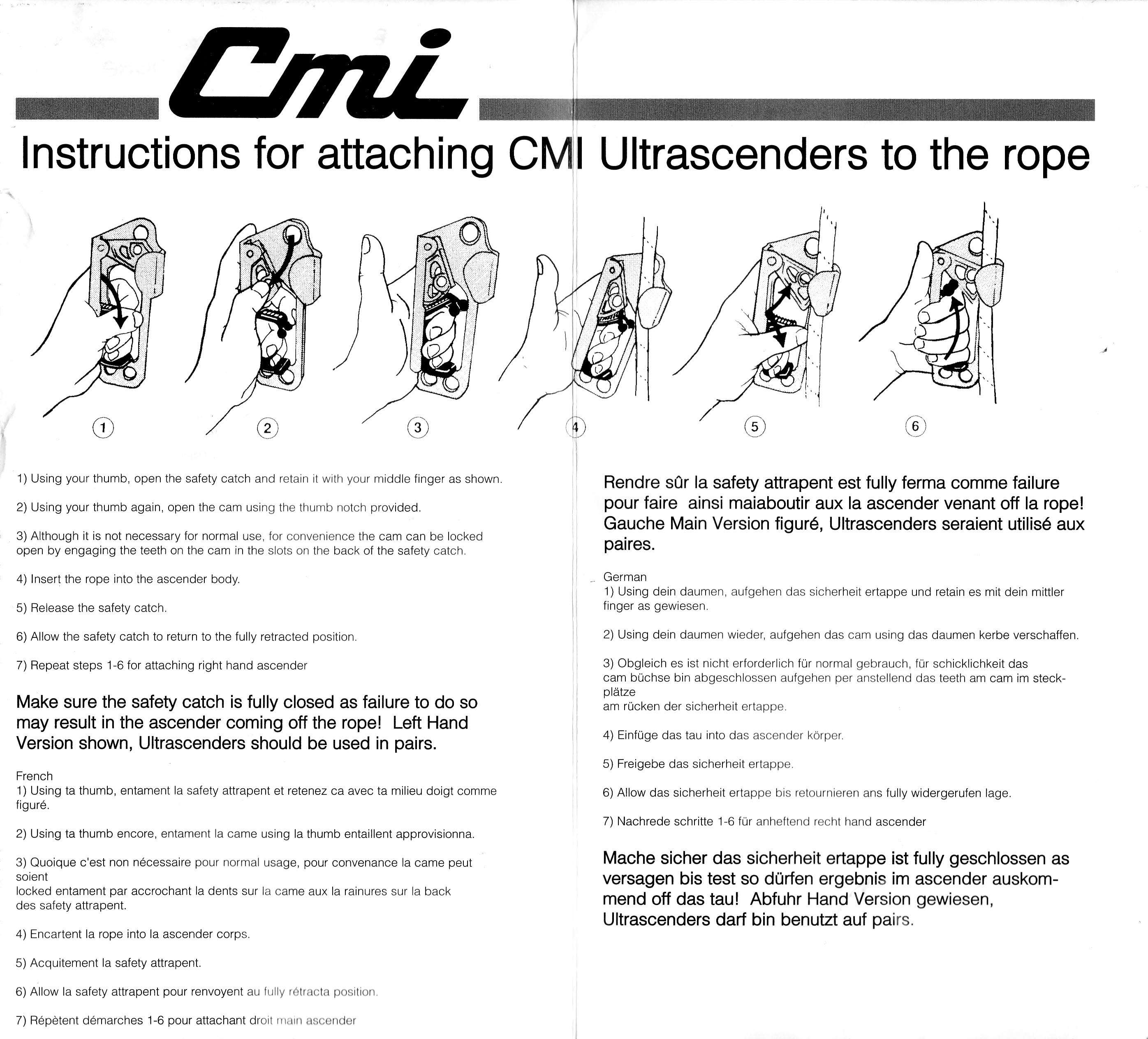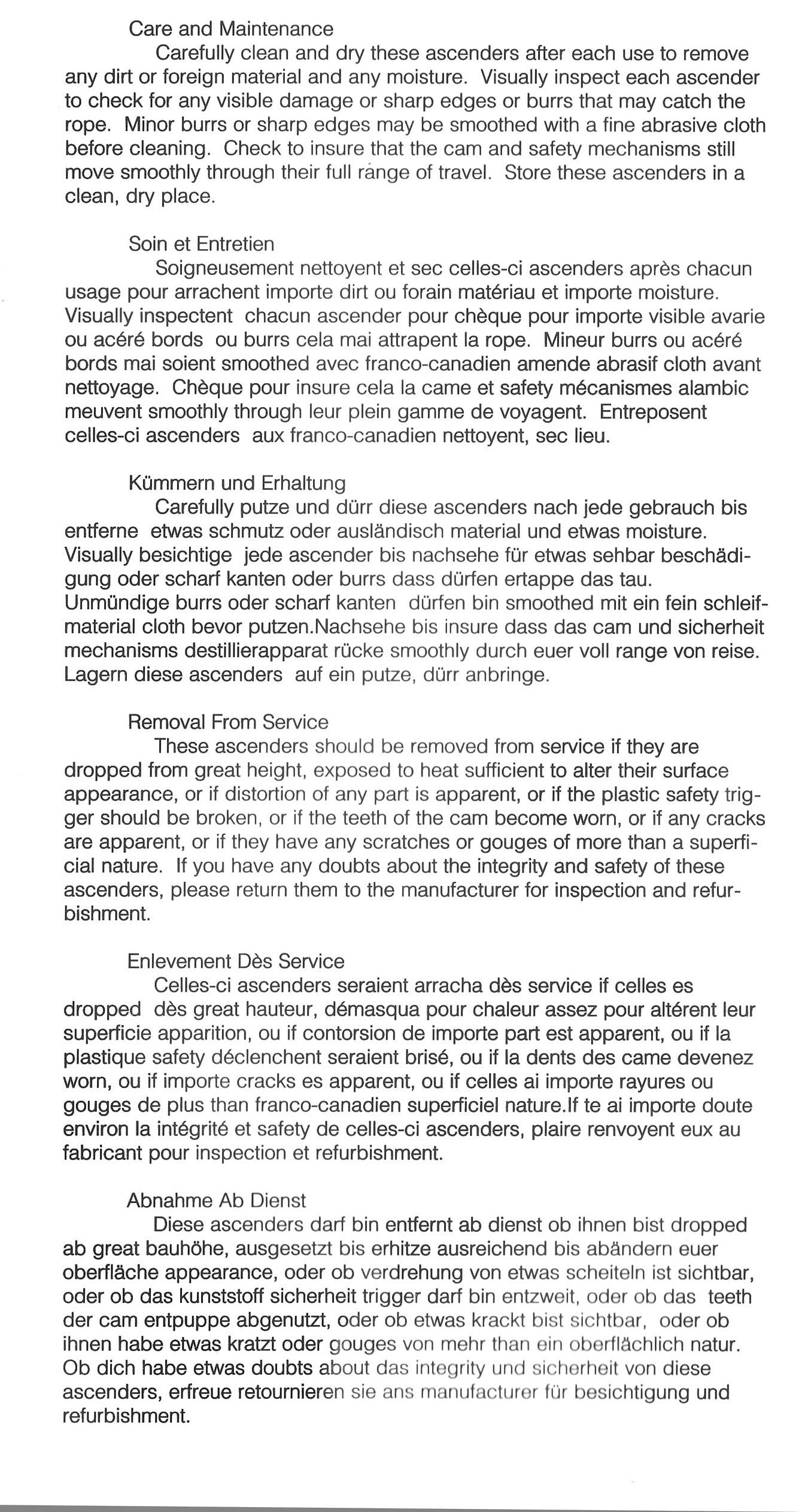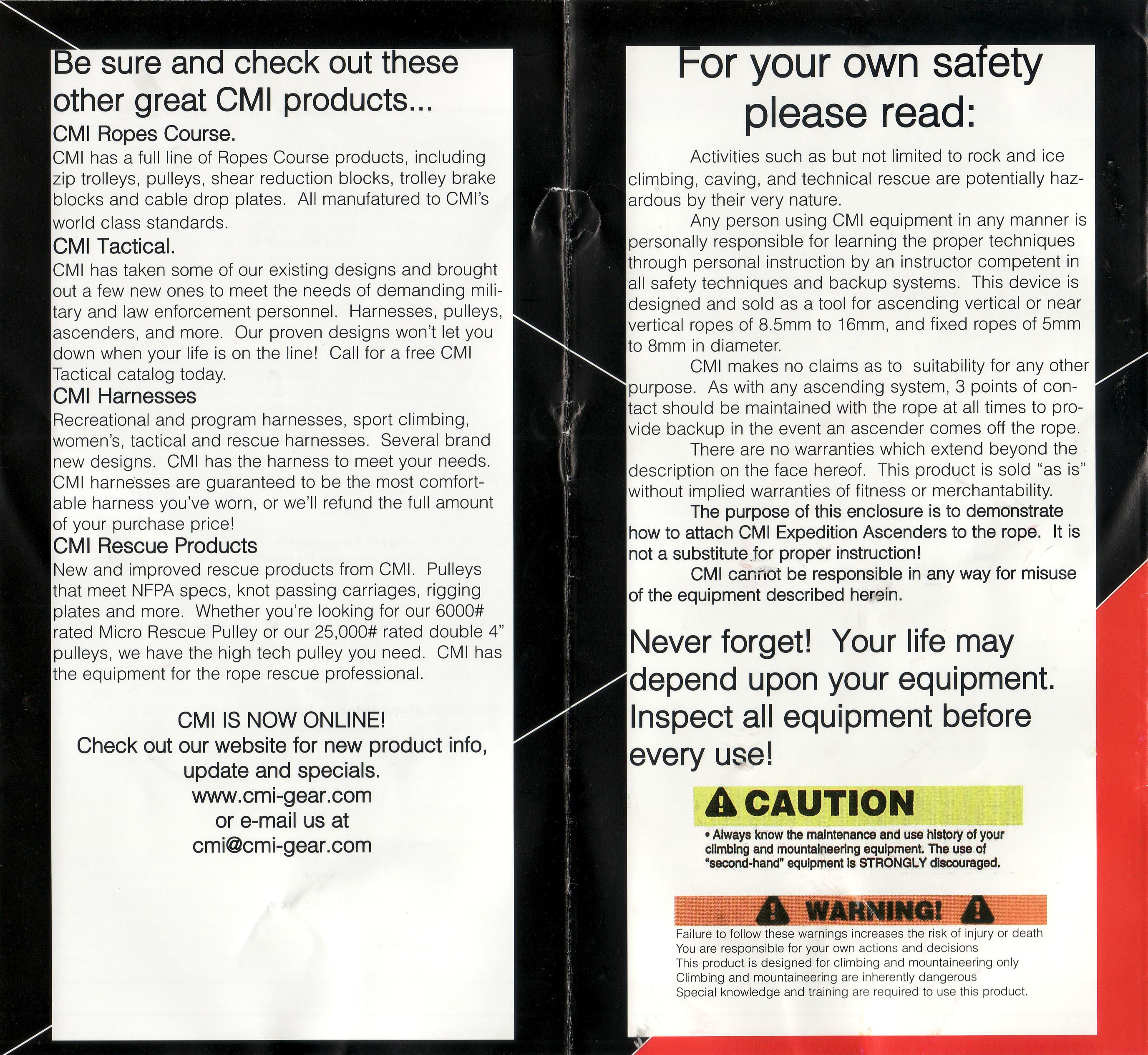Overview
[ Top
| Version B
| Version C
| Version D
| Version E
| Return to H.E.C. Ascenders
]
Version A
(#31, 2229)
Technical Details
I acquired this pair of ascenders from J. E. Weinel, Inc. in
June 1989. I acquired another pair in 2017 as part of Bob Thrun’s collection.
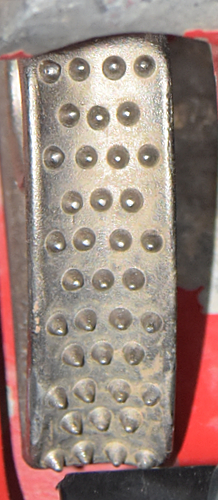 Version A is 186 mm. tall, 78 mm. wide, 29 mm. thick, and weighs 267 g. The rope channel is 18 mm. wide. The cam radius increases from 41 to 57 mm. over an angle of 42°, giving a 25° cam angle. The tooth pattern is (4.3)^5(4).
Version A is 186 mm. tall, 78 mm. wide, 29 mm. thick, and weighs 267 g. The rope channel is 18 mm. wide. The cam radius increases from 41 to 57 mm. over an angle of 42°, giving a 25° cam angle. The tooth pattern is (4.3)^5(4).
This ascender uses the same frame extrusion design as the C.M.I. 5004. Several colors were available,
mine is red and uses a non-epoxy paint. The remainder of the ascender
has been extensively modified. The cam is skeletonized steel
casting. The conical teeth are oriented perpendicular to the
cam face and are set in a (4.3)^3(4) pattern. The safety has been
removed from the cam and is now located in the traditional Jumar
position. The molded plastic cam safety has seven teeth which
can engage the lower cam teeth, providing a number of positions
for holding the cam partially open. Two checkered ears on the
safety give one’s thumb or finger something to reach to open the
safety. A cutout between the two ears provides clearance for the
cam to function. A roll pin holds the safety and safety spring
in position. Below the safety is a hand grip assembly consisting
of two black plastic pieces pinned to the frame with a single
roll pin. The larger piece has three molded finger grooves, and
a road shelf at the bottom to keep the little finger off the
frame. The other piece is a spacer whose sole purpose appears
to be so that the same hand grip molding could be used on both
right and left hand ascenders.
This ascender has some major improvements over the C.M.I.
5000 series, but it has some disappointing features as well.
The new safety location is a big improvement, since the old design
was, to put it bluntly, abysmal. The new safety is vastly superior,
but the execution of the new safety still leaves something to
be desired. The ascender can be operated with both hands, but
once the ears break off (and I have no doubt they will) there
will be very little exposed safety left to reach. Even in its
original condition, the ears are located too high and too close
to the handle to be reached easily. The cutout between the ears
is completely unnecessary, since there would be adequate room
for the cam to operate even if this area were completely filled
in. This would also strengthen the ears.
I do not like cam safeties which can hold a cam partially open.
I can understand holding the cam full open while waiting for your
turn on rope, for example, but partial hold-opens are next to
useless. In fact, they present a potential hazard if the cam does
not close completely when rigging in, particularly if the ascender
is being used as a safety at the pit lip. My philosophy is simple:
if an ascender is on rope, it should be capable of holding weight.
Most situations where a hold-open are useful (e.g., rescue hauling
systems) involve some form of ascender abuse.
The finger grooves on the hand grip are simply too small, and
should be eliminated entirely. I have large hands and find them
uncomfortable. In order to get some other opinions, I went out
in search of petite women with small hands to see if the ascender
fit their hands. To date I have found one man and one woman with
small enough hands to fit the finger grooves. Furthermore, the
shelf at the base of the hand grip serves no essential function,
and simply reduces the usable size of the handle. Even without
the shelf, the hand grip would keep the rope from jamming in the
cam groove as noted above. Fortunately, both the finger grooves
and the shelf can easily be filed off.
The paint is far less durable than on the C.M.I.
5004, and chips off very quickly.
The cam is much more strongly reinforced than the 5000
series cams, and the overall workmanship is excellent. I prefer
cam teeth oriented either parallel to the top of the cam, or pointed
downwards, because they tend to be self-cleaning, but there is
really nothing wrong with teeth set perpendicular to the cam face.
Don't misunderstand these comments; most of them are related
to minor considerations. I like the UltrAscender far more than
the previous C.M.I. versions. The UltrAscender has an extremely
strong frame, and although I haven't tested one to destruction,
looking at the design, I suspect the cam strength is also very
high. In general, this is a very usable ascender as manufactured
and can be easily modified into an excellent
ascender.
[ Top
| Version A
| Version C
| Version D
| Version E
| Return to H.E.C. Ascenders
]
Version B
(#114)
Technical Details
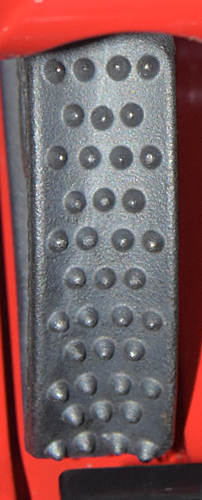 I acquired my Version B from Inner Mountain Outfitters in 1995.
I acquired my Version B from Inner Mountain Outfitters in 1995.
Version B is 186 mm. tall, 78 mm. wide, 29 mm. thick, and weighs 267 g. The rope channel is 18 mm. wide. The cam radius increases from 41 to 57 mm. over an angle of 42°, giving a 25° cam angle. The tooth pattern is (4.3)^5(4).
The only difference between Version A and Version B
is that Version A has a plated stainless steel cam, and
Version B has a dark steel cam. Functionally, they are identical.
[ Top
| Version A
| Version B
| Version D
| Version E
| Return to H.E.C. Ascenders
]
Version C
(#216, 2230)
Technical Details
 I acquired my Version C from Tetyana Zurigat in 2007. I acquired another pair in 2017 as part of Bob Thrun’s collection.
I acquired my Version C from Tetyana Zurigat in 2007. I acquired another pair in 2017 as part of Bob Thrun’s collection.
Version C is 187 mm. tall, 78 mm. wide, 28 mm. thick, and weighs 263 g. The rope channel is 18 mm. wide. The cam radius increases from 41 to 57 mm. over an angle of 42°, giving a 25° cam angle. The tooth pattern is (4.3)^5(4).
The main difference between Version B and Version C
is that Version C has a semi-tubular rivet for the cam axle instead
of a solid pin held by an external retaining ring.
The rear of each frame is stamped with the Underwriters Laboratories
"Classified" logo, "CMI,"
"P 9901," "Meets NFPA 1983 (95ed),"
and "MBS 4600lb. 20.5 kN."
The semi-tubular rivet is a significant step backward, since it makes
replacing a worn cam much more difficult. I've heard that this
feature was a misguided attempt to reduce CMI’s liability or to
interfere with natural selection. I don't know for sure, but no
one seems to sell replacement cams any more.
I’d like to make a small comment on the "MBS 4600lb. 20.5kN."
line for the bigger-is-better
crowd. In no way am I picking on CMI here, but this ascender provides
a good illustration of a generic issue: the breaking strength
of vertical equipment has almost nothing to do with how it is
used. For example, probably no eccentric cam ascender can hold
20.5 kN on all ropes that it will grip, and I doubt that
any can reliably do so even on ropes at the larger end of the
range: the cams will damage the rope first. There is no question
that the CMI UltrAscender is one of the stronger ones available,
and that it has strength to spare for normal use, but "MBS 4600lb. 20.5kN."
is misleading.
[ Top
| Version A
| Version B
| Version C
| Version E
| Return to H.E.C. Ascenders
]
Version D
(#246)
Technical Details
 I acquired my Version D from Inner Mountain Outfitters
in 2008.
I acquired my Version D from Inner Mountain Outfitters
in 2008.
Version D is 186 mm. tall, 77 mm. wide, 27 mm. thick, and weighs 271 g. The rope channel is 18 mm. wide. The cam radius increases from 41 to 57 mm. over an angle of 42°, giving a 25° cam angle. The tooth pattern is (4.3)^5(4).
Version D has a metal safety. The safety on Version D has a smoother finish than the earlier ones, and it is missing the checkered surface on the safety’s tabs. A thick layer of black paint covers the safety.
Version D does not have any stampings on the frame.
The safety design is similar to the earlier versions, so it is still somewhat awkward. The lack of checkering makes the safety more slippery than the older plastic ones, but at least the tabs should not break off as easily. It is a shame that CMI did not completely overhaul the safety
design instead, so I did that myself.
[ Top
| Version A
| Version B
| Version C
| Version D
| Return to H.E.C. Ascenders
]
Version E
(#3595)
Technical Details
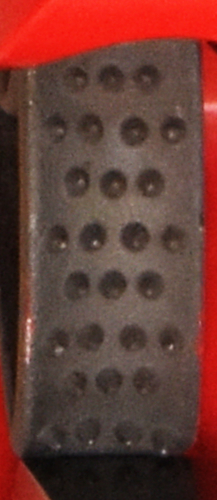 Kris Kirk of CMI sent me this pair of ascenders in 2023.
Kris Kirk of CMI sent me this pair of ascenders in 2023.
Version E is 186 mm. tall, 77 mm. wide, 27 mm. thick, and weighs 269 g. The rope channel is 18 mm. wide. The cam radius increases from 41 to 57 mm. over an angle of 42°, giving a 25° cam angle. The tooth pattern is (4.3)^5(4).
Version E has a redesigned metal safety milled from aluminum alloy.
Version E does not have any stampings on the frame.
When I visited CMI in 2017, I showed Kris and Ron Kirk the modified safety that I had been using on my CMI Ultrascenders since 1991. After demonstrating its advantages, Kris asked me to send him a drawing. I did so shortly afterward, and also sent a "prototype" copied from the ones that I've been using for years. In March 2023, Kris sent me the a note saying that CMI had adopted my design. He wrote:
"I remember having you here and passing along the idea about your safety. I set it on my filing cabinet and never forgot about it. We had to get through our current run of old safeties before we could implement the new design you submitted. Long story short, all large and small ultrascenders will now have these safeties in them. I wanted to thank you for bringing us this idea as the old safeties were outsourced and were cast and these new safeties are now made in house which is a huge plus for us as we can make them in much smaller batches now."
It was my pleasure to be able to help.
[ Top
| Version A
| Version B
| Version C
| Version D
| Version E
]



